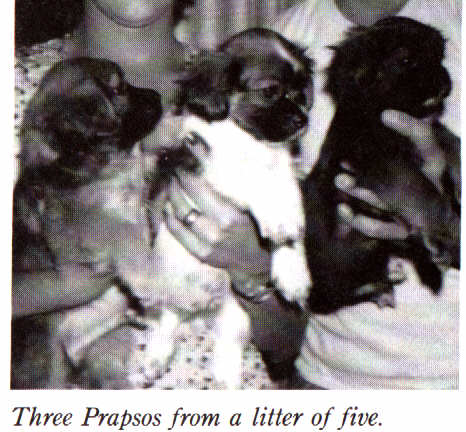PRAPSO PUPPIES

Occasionally,
there is an “odd” occurrence during whelpings.
It is not restricted to Lhasa Apsos, but occurs in other breeds as
well. This is the whelping of a smooth
coat, or as the Australians call them, a Prapso.
When
the first Prapsos occurred, it must have been quite a shock for the breeders
involved. Most tried to keep these
puppies a secret, but the news leaked out.
It does appear to have been a worldwide phenomenon, which occurred after
World War ll. The Prapsos were not
restricted to one line of Lhasas, but seemed to affect many.
The
Australian breeders took “the bull by the horns” and determined to find the
cause, if possible. Mrs. Joan Beard
started searching for information both in Australia and overseas. All identification of material was kept
confidential, and the information was forwarded to CHART, an organization in
England, which researches animal abnormalities. Geneticists worked on the charts prepared by this organization.
Facts
about Prapsos started to become apparent.
Test matings ruled out straight dominant or recessive genes. CHART’s report indicated that the cause was
quantitative characteristics. This type
of inheritance results from the interaction of numerous genes affecting each
other in differing degrees. Although
additional research has turned up new knowledge about genetics, no recent
information on this problem has been located.
Since
the passing of alleles to offspring is accomplished in a random manner, there
are several possible explanations for the results of quantitative
characteristics. One is the inheritance
of mutations, genes whose chemical structures have been slightly altered or
changed. These mutations could have
been spontaneous in nature, or they could have been caused by exposure either
to chemicals or to radiation. During
the period when many of these Prapsos occurred, new pesticides such as DDT were
quite popular. Now it is known that
these may cause gene defects.
Another
possibility is that there may have been a protein shift in that one of the
amino acid bases of those genes, which order coats. This chemical change might then have changed a gene or genes,
which in some way affect coat characteristics.
This
small bit of genetic knowledge may help breeders to do a better job until the
exact gene on the exact chromosome may be located. There is for instance, no reason to rule good Lhasas out of
breeding programs because Prapsos have been produced. However, they must be used with care. Such breedings should not be repeated. The bitch owner should use judicious care in subsequent
breedings. Most bitches that produced
Prapsos when bred to one sire did not when bred to others.
Much
responsibility lies with the owner of a stud that has produced Prapsos, as a
stud can sire many more puppies than one bitch can produce. The owner of the stud should keep accurate
records, should examine carefully the pedigrees of bitches to be bred, and
should the potential of Prapsos be present, either refuse the breeding or
clearly explain the potential to the bitch’s owner. Such a stud will be able to produce his many good characteristics
if care and discretion are practiced.
Notice the short broken looking coat on this puppy.

Prapsos
have several characteristics, which are apparent quite early. One aspect is muzzle hair. On a Lhasa puppy, it grows like a
chrysanthemum’s petals, spreading out using the nose as a focal point. The muzzle hair on the Prapsos is
smooth. In the coats of the Prapsos,
there will be shiny, stiff hairs, which are like coarse guard hairs. The Prapsos may have no hair between the
pads, a distinguishing factor of Lhasa Apsos, and may have hare feet, a sparse
head fall, no feathering on the fronts of the legs, and abruptly short
coats. It is also said Prapsos cut
their primary (baby) teeth by four to four and one-half weeks, when the average
Lhasa may be just starting to cut his.
There are several factors to remember: Avoid repeat breedings of those
resulting in Prapsos; sell Prapsos as pets on neutering contracts; keep
complete records; and use discretion.
As
a guideline, I suggest you find out as much as possible about the good and bad
qualities of the dogs in your pedigrees.
Cooperate as much as possible.
Take special care when using dogs close to imports without
pedigrees. Keep complete records of
teething, development etc. Do not
repeat matings, which give disappointing results. Try to find those that "nick" and stick to the
combination. Keep and breed from those animals nearest the Official Standard,
bearing in mind that they must be sound in both mind and body as well as
typical.
Those who have followed these simple rules have
found that Prapsos can occasionally turn up, often in unexpected places, but it
is now under control and can hardly be called a "problem".
On no account, ever breed from a Prapso or a
semi. Sell them as pets without papers
or give them away to friends.
Information gathered from: Lhasa
Lore by Sally Ann Vervaeke-Helf
Joan Beard, Asian Breeds Bulletin, Sydney, Australia,
May 1970 pp. 4,5.